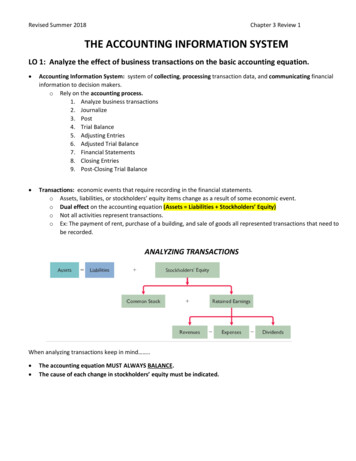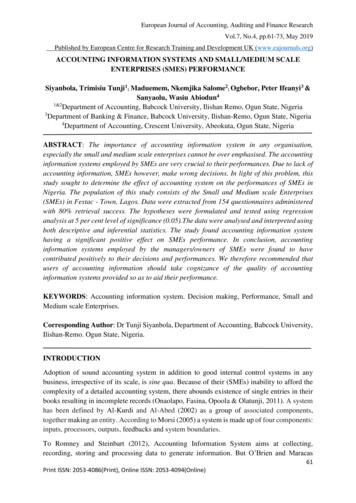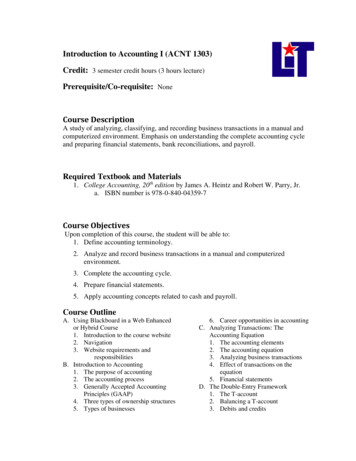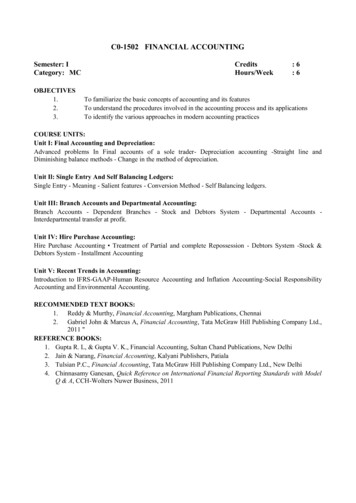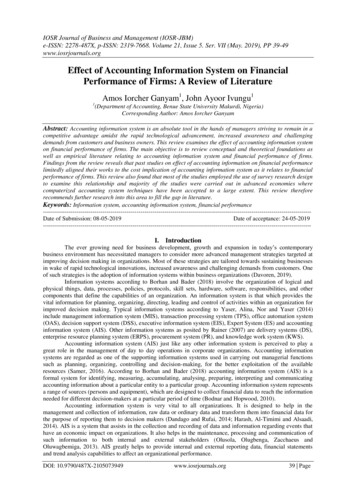
Transcription
IOSR Journal of Business and Management (IOSR-JBM)e-ISSN: 2278-487X, p-ISSN: 2319-7668. Volume 21, Issue 5. Ser. VII (May. 2019), PP 39-49www.iosrjournals.orgEffect of Accounting Information System on FinancialPerformance of Firms: A Review of LiteratureAmos Iorcher Ganyam1, John Ayoor Ivungu11(Department of Accounting, Benue State University Makurdi, Nigeria)Corresponding Author: Amos Iorcher GanyamAbstract: Accounting information system is an absolute tool in the hands of managers striving to remain in acompetitive advantage amidst the rapid technological advancement, increased awareness and challengingdemands from customers and business owners. This review examines the effect of accounting information systemon financial performance of firms. The main objective is to review conceptual and theoretical foundations aswell as empirical literature relating to accounting information system and financial performance of firms.Findings from the review reveals that past studies on effect of accounting information on financial performancelimitedly aligned their works to the cost implication of accounting information system as it relates to financialperformance of firms. This review also found that most of the studies employed the use of survey research designto examine this relationship and majority of the studies were carried out in advanced economies wherecomputerized accounting system techniques have been accepted to a large extent. This review thereforerecommends further research into this area to fill the gap in literature.Keywords: Information system, accounting information system, financial ---------------------------------------------Date of Submission: 08-05-2019Date of acceptance: ---------------------------------------------I. IntroductionThe ever growing need for business development, growth and expansion in today’s contemporarybusiness environment has necessitated managers to consider more advanced management strategies targeted atimproving decision making in organizations. Most of these strategies are tailored towards sustaining businessesin wake of rapid technological innovations, increased awareness and challenging demands from customers. Oneof such strategies is the adoption of information systems within business organizations (Davoren, 2019).Information systems according to Borhan and Bader (2018) involve the organization of logical andphysical things, data, processes, policies, protocols, skill sets, hardware, software, responsibilities, and othercomponents that define the capabilities of an organization. An information system is that which provides thevital information for planning, organizing, directing, leading and control of activities within an organization forimproved decision making. Typical information systems according to Yaser, Alina, Nor and Yaser (2014)include management information system (MIS), transaction processing system (TPS), office automation system(OAS), decision support system (DSS), executive information system (EIS), Expert System (ES) and accountinginformation system (AIS). Other information systems as posited by Rainer (2007) are delivery systems (DS),enterprise resource planning system (ERPS), procurement system (PR), and knowledge work system (KWS).Accounting information system (AIS) just like any other information system is perceived to play agreat role in the management of day to day operations in corporate organizations. Accounting informationsystems are regarded as one of the supporting information systems used in carrying out managerial functionssuch as planning, organizing, controlling and decision-making, for the better exploitation of the availableresources (Samer, 2016). According to Borhan and Bader (2018) accounting information system (AIS) is aformal system for identifying, measuring, accumulating, analysing, preparing, interpreting and communicatingaccounting information about a particular entity to a particular group. Accounting information system representsa range of sources (persons and equipment), which are designed to collect financial data to reach the informationneeded for different decision-makers at a particular period of time (Bodnar and Hopwood, 2010).Accounting information system is very vital to all organizations. It is designed to help in themanagement and collection of information, raw data or ordinary data and transform them into financial data forthe purpose of reporting them to decision makers (Dandago and Rufai, 2014; Harash, Al-Timimi and Alsaadi,2014). AIS is a system that assists in the collection and recording of data and information regarding events thathave an economic impact on organizations. It also helps in the maintenance, processing and communication ofsuch information to both internal and external stakeholders (Olusola, Olugbenga, Zacchaeus andOluwagbemiga, 2013). AIS greatly helps to provide internal and external reporting data, financial statementsand trend analysis capabilities to affect an organizational performance.DOI: 10.9790/487X-2105073949www.iosrjournals.org39 Page
Effect Of Accounting Information System On Financial Performance Of Firms: A Review From the foregone, it is expected that accounting information system (AIS) should be correlated withthe financial state and outcomes of firms. Financial performance is a composite of an organization’s financialhealth, its ability and willingness to meet its long term financial obligations and its commitments to provideservices in the foreseeable future. In a broader sense, financial performance refers to the degree to whichfinancial objectives are accomplished. Financial managers need the financial and accounting data provided byAIS to evaluate the firm’s past performance and to map future plans. The outcomes of AIS which primarilyincludes financial reports, are required at different levels of management and by other stakeholders. In fact, theoutcomes of an AIS feeds into various decision streams at operational, tactical, and strategic levels of theorganization. Users require financial and related information with various degrees of detail and with variouslevels of analysis.Consequently, accounting information system (AIS) as a computer- based application, accompaniesitself with innovate and modern ways of accounting practices which most business owners especially indeveloping countries are not prepared for or find it very difficult to adopt. Yet, organizations are designing evenmore sophisticated accounting information systems to meet up with strategic goals and enhanced performance(Eb, Pretorious and Zuva, 2013). Typical problems faced by smaller firms such as the small and medium scaleenterprises (SMEs) particularly in developing countries in the adoption of computerized accounting system arelack of capital and technological obsolescence, limited financial resources, management information, limitedscale economies and management’s IT-oriented behavior, and lack of funds to improve skills (Malaranggeng,2009; Levy, Powel, Yetton and Francalanci 2011; and Morabito, 2008; Marriot and Marriot, 2000).This article seeks to provide a substantial review on the effect of accounting information system (AIS)on financial performance of firms. Specifically, it attempts to document empirical researches on accountinginformation system and to identify research gap related to effect of accounting information system and financialperformance of firms as a basis of an empirical future research.II. Conceptual Clarifications2.1 Accounting Information SystemAccounting information system according to Manchilot (2019) may be a computer-based electronicsystem used for collecting, storing, processing and communicating financial and accounting data throughfinancial statements with the aim of supporting and guiding organizational decision making process. Computersare the hub of accounting information as they provide a platform for the workability of all information systems.For an accounting information system to be operational, its appropriate software application must be on thecomputer system intending to be used.Borhan and Bader (2018) defined accounting information system is a system which contains a group ofharmonized business, components, and resources which processes, manage, and control the data for producingand carrying the relevant information for decision makers in the organization. Accounting information requiresseries of processes to carry out its function just like any other system. It is a connected and homogeneous set ofthe resources and different components (human, equipment, finance, etc) that interact simultaneously inside aspecific framework to work towards the achievement of organizational goals.According to Borhan and Nafees (2018) accounting information system is the process of collecting,analyzing and converting data into action. This definition justifies accounting information system as a computerbased system that collects data, process and analyses data and produces results or output.Kashif (2018) states that accounting information system is a combination of people, equipment,policies, and procedures that work together to collect data and transform it into useful information. AIS is asystem that provides people with either data or information relating to an organization's operation to support theactivities of employees, owners, customers, and other stakeholders in the organization's environment byeffectively supplying information to authorized people in a timely manner.2.2 Relevance of Accounting Information SystemThe main function of AIS is to assign quantitative value of the past, present and future business events(Rehab, 2018). Accounting information, in the form of periodic reports or special analyses, is often a source ofinformation for making decisions. These decisions may include pricing, production levels and product mix,outsourcing, inventory policy, customer servicing, labour negotiations, and capital investments (Horngren,Harrison, Bamber, Willis and Jones, 2005; Sprinkle, 2003).Accounting information systems play an important role in the implementation of the managerialfunctions of the organization such as planning and control (Samer, 2016). In the planning function, AIS providedata relating to study and analyze the goals set for the organization. It also provide information regarding therelationship between cost, volume and profit required to determine the amount of interdependence andinteraction between them. AIS under the planning function also helps in preparing lists of future needs andfinancial flows and planning of budgets for the development of quantitative criteria and converting them intoDOI: 10.9790/487X-2105073949www.iosrjournals.org40 Page
Effect Of Accounting Information System On Financial Performance Of Firms: A Review financial standards to reflect the different aspects an organization's activities and presentation of the detailedplans and policies of the work and coordination across different departments (Frezatti, Andson, Guerreiro andGouvea (2011). On the other hand, in the control function, it requires a clear and specific plan that shows thedesired objectives and defines the foundations on which results are evaluated and analyzed in order to correctdistractions. This function is regarded as a practical test of decision making and implementation, follow up theactual implementation in accordance with the plans, policies and standards established, the discovery ofdeviations and correct them, provide reasons to protect the property of the shareholders and the preservation oftheir interests, resource development and follow up the activity of the organization, and to achieve the desiredgoals, thus ensuring the effectiveness of the organization (Onaolapo and Odetayo, 2012).Computerized accounting tools as integral part of AIS are directly related to the economic and financialresults of firms (Urquía, Pérez, and Muñoz, 2011). Advantages of an optimal use of AIS in an organizationmight include: Better adaptation to a changing environment, better management of internal business transactionsand a high degree of competitiveness. There is also a boost to the dynamic nature of firms with a greater flow ofinformation between different staff levels and the possibility of new business on the network and improvedexternal relationships for the organization, mainly with foreign customers accessed through the firm’s web(Pérez, Urquía and Muñoz, 2010).2.3 Subsystems of Accounting Information SystemAccording to Hall (2008) an accounting information system may be divided into four major subsystems including the transaction processing system, general ledger/financial reporting system, fixed assetsystem and management reporting system. The transaction processing system supports daily business operationswith numerous documents and messages for users throughout the organization. Transaction processing systems(TPS) are the basic business systems that serve the operational level of the organization. A transactionprocessing system is a computerized system that performs and records the daily routine transactions necessary tothe conduct of the business (Laudon and Laudon, 2006).The general ledger/financial reporting system produces the traditional financial statements, such asincome statements, balance sheets, statements of cash flows, tax returns, and other reports required by law. Thissystem is designed to collect data and information on AIS, customers, suppliers and wages, closure ofaccounting books, preparation of trial balance and a list of results and the budget of the organization and thereports of income and expenses and submit these statements to the owners and investors (Samer, 2016). Thereliance of this system on the computer help the organization in cutting costs and using the fewest number ofworkers as well as in the completion of the accounting task in an accurate and orderly manner, and conductingfinancial control process.Fixed asset system processes transactions pertaining to the acquisition, maintenance, and disposal offixed assets, while the management reporting system, which provides internal management with special purposefinancial reports and information needed for decision making, such as budgets, variance reports, andresponsibility reports.Samer (2016) also identified some subsystems of accounting information system to include inventorycontrol system, customer accounts system, suppliers account system and payroll system. The inventory controlsystem is designed to process the bills of stored materials, identify materials that need to be re-supply, andgenerate reports showing the inventory situation. The reliance of this system on the computer help theorganization in customer service, recording changes in the level of inventory, reducing costs, and preparingdocuments.Customers' accounts system is designed to determine amounts owed by customers in accordance withthe information of payment and purchase processes. Additionally, the system is intended to produce a monthlycustomer accounts and credit reports. A computer-based customer accounts system provide the organizationwith accurate bills and monthly reports on credit provided to customers, which in turn enhances the processes ofpayment, collection and provision of liquidity.Suppliers accounting system provides daily information on procurement and payment to suppliers,preparing checks, pay bills and treasury reports. The reliance of this system on the computer results inestablishing good working relationships and achieving a good credit price and taking advantage of discountsthrough the payment to suppliers quickly and accurately, and financial control on the amounts paid by theorganization.Payroll system is designed to display daily data on workers and attendance cards, generate paymentchecks and workers' payrolls, prepare special reports on work analysis The reliance of the system on thecomputer help the organization in the preparation and submission of special reports related to tax, returns,deductions and analysis of labour productivity and labour costs.The list of subsystems of accounting information systems are not limited as these systems are designedfor management of firms to meet their day to day accounting need.DOI: 10.9790/487X-2105073949www.iosrjournals.org41 Page
Effect Of Accounting Information System On Financial Performance Of Firms: A Review 2.4 Components of Accounting Information SystemIn a typical organization setting, accounting information system (AIS) is made up of severalcomponents. According to Rommeny and Stenbart (2006) accounting information system is made up of sixcomponents as presented in Figure 1.Figure 1: components of accounting information systemSource: Rommeny and Stenbart, (2006)Individuals play a vital role in ensuring that accounting information system achieves its purpose. Theyinclude people who control the functions of the system and undertake diverse functions. AIS just like any otherinformation system require raw data for processing. Data in this regard, refers to all raw facts and figures relatedto the operations of an organization. Preference is also laid on all methods that collect, operate, store data relatedto operations carried out by the organization whether manual or automated. Software in this context refers to allapplications used to run organizations’ operations. Personalization of accounting information systems byorganizations is evident in AIS software development and acquisition. They play a vital role in AIS quality.Information technology infrastructure includes all means and devices that serve the AIS while internal controland the requirements of information security both ensures qualitative output from the day to day usage ofaccounting information systems (Rommeny and Stenbart, 2006).2.5 Financial PerformanceFinancial performance is a composite of an organization’s financial health, its ability and willingness tomeet its long-term financial obligations and its commitment to provide services in a foreseeable future (Weber,2008). Financial performance refers to the act of performing financial activity. In broader sense, financialperformance refers to the degree to which financial objectives being or has been accomplished. It is the processof measuring the results of a firm's policies and operations in monetary terms.Financial performance is broadly viewed as the ability of the firm to meet its financial objectives. Twoprominent indicators of financial performance are investor’s return and accounting returns. The investors returnis measured from the perspective of the shareholders, whereas accounting return focus on how the firm’searning respond to different managerial policies (Ofoegbu, 2003).According to Farah, Farrukh, and Faizan (2016) financial performance is an extent to which a companyfinancial health over a period of time is measured. In other words, it is a financial action used in order togenerate higher sales, profitability and worth of a business entity for its shareholders through managing itscurrent and non-current assets, financing, equity, revenues and expenses. Its main purpose is to provide financialinformation to shareholders and stakeholders so as to enable them make well informed investment decisions. Itcan be used to evaluate similar companies from the same industry or to compare industries in aggregation.2.6 Measures of Financial PerformanceAccording to Encyclopedia of Business (2011) performance measures can be grouped into two thosethat relate to results (outputs or outcomes such as competitiveness or financial performance) and those that focuson the determinants of the results (inputs such as quality, flexibility, resource utilization, and innovation). Thissuggests that performance measurement frameworks can be built around the concepts of results anddeterminants. Zuriekat, Salameh and Alrawashdeh (2011) on the other hand opined that performancemeasurement systems are considered information systems that are used to evaluate both individual andorganizational performance.DOI: 10.9790/487X-2105073949www.iosrjournals.org42 Page
Effect Of Accounting Information System On Financial Performance Of Firms: A Review Measuring the performance of the company is done using different measures. The literature review ofFiori, Di'Donato and Izzo (2009) indicated that financial performance can be measured based on the firm’s:solvency, repayment capacity, profitability, efficiency and liquidity.According to Lin and Liu (2005) financial ratios are usually one of the indicators used to evaluate a firm’sperformance. Generally, the financial information of a company’s business operations will be reported in theyearly financial statements, and a financial ratio simply constitutes one item divided by another in the financialstatement. Financial ratios can be viewed as a preliminary reference for the analysis of the businessperformance.Traditionally, the measurement of a firm’s performance usually employs the financial ratio method,because it provides a simple description about the firm’s financial performance in comparison with previousperiods and helps to improve its performance of management. However, Glautier and Underdoon (2009)maintained that there are two aspects of a company’s financial performance of interest to investors. First, itsfinancial performance may be assessed by reference to its ability to generate profit. This agrees with Pandey(2004) who asserts that it is assumed that profit maximization causes the efficient allocation of resources underthe competitive market conditions, and profit is considered as the most appropriate measure of a firm’sperformance. Thus, ratios of financial efficiency in this respect focus on the relationship between profit andsales and profit and assets employed. Second, the company’s financial performance may be assessed in terms ofthe value of its shares to investors. In this way, ratios of financial performance focus on earnings per share,dividend yield and price/ earnings ratios. The ratios used to measure the overall profit performance of a firm aretermed financial ratios.III. Theoretical Foundations3.1 Contingency TheoryThe contingency theory was first proposed by Fiedler in 1964 as managerial leadership theory.According to Fiedler (1964) the contingency theory suggest that there is no one best way of leading and that aleadership style that is effective in one situation may not be successful in others.Gordon and Miller (1976) however laid out the basic framework for considering accountinginformation systems from a contingency perspective where the accounting information systems also need to beadaptive to the specific decisions being considered within a framework.Contingency theory suggests that an accounting information system need to be adapting to desiredspecific decisions while considering the environment and organizational structure confronting an organization(Dandago and Rufai, 2014).Applying this to the subject, contingency theory suggests that in order to improve performance,managers of firms must devote particular attention to their use of accounting information system, taking care toadopt the systems best tailored to their special circumstances.There are some criticisms of the Fiedler’s contingency theory. However, one of the biggest criticismsof the contingency theory that best relates to the study under review is lack of flexibility (Mitchell, Biglan,Oncken, and Fiedler, 2017). Fiedler (1964) believed that because natural leadership style is fixed, the mosteffective way to handle situations is to change the leader. The theory does not allow for flexibility in leaders(Mind Tools, 2018). Relating this to the study indicates that managers will incur more cost to change accountinginformation system that does not tender to their required decision needs rather than carryout modifications.3.2 Resource-based view TheoryThe resource-based view theory was propounded by Barney in 1991. According to Barney (1991) theresource-based view avers that the source of sustainable advantage derives from doing things in a superiormanner; by developing superior capabilities and resources. The resource-based view proffers a means ofevaluating potential factors that can be deployed to confer a competitive edge for business organizations. A keyinsight arising from the resource-based view is that not all resources are of equal importance, nor do theypossess the potential to become a source of sustainable competitive advantage.The resource-based theory is divided into three levels; capability, competence and skills. (Cragg,Caldeira and Ward, 2011). Capability refers to how firms manage their resources; competence, refers to howwell those resources are managed, and skills are associated with ranges of skills such as technical, managerialand general management skills. Accounting information systems also form part of resources available to firms.Inclining the resource-based view theory with accounting information systems and performance will imply thatfirms properly and adequately manage accounting information systems to utilize its capability competence andskill sets for improved organizational performance.The resource based view theory has faced several criticisms. One of such criticism is that the theorylacks substantial managerial implications or operational validity (Priem & Butler, 2001). It seems to tellmanagers to develop and obtain valuable, rare, inimitable, and non-substitutable resources and develop anappropriate organization, but it is silent on how this should be done (Connor, 2002; Miller, 2003). (Lado, Boyd,DOI: 10.9790/487X-2105073949www.iosrjournals.org43 Page
Effect Of Accounting Information System On Financial Performance Of Firms: A Review Wright and Kroll, 2006) also argues the resource-based view theory suffers a tension between descriptive andprescriptive theorizing. However, Barney and Clark (2007) posits that the resource-based view theory is a theoryaspiring to explain the sustained competitive advantage of some firms over others and, as such, was neverintended to provide managerial prescriptions. In concurrence with this assertion, any explanations the resourcebased view theory might provide may not be indicative, yet still of value to managers, so there may be no reasonto oblige the resource-based view theory to generate theoretically compelling prescriptions.3.3 Agency TheoryThe agency theory was championed by Jensen and Meckling in 1976. The agency theory describes theowners’ (principals’) delegated authority to manager (the agent) to run the firm on his or her behalf with theowners’ welfare depending on the manager accordingly (Jensen and Meckling, 1976). The agency theory seeksto address the potential conflict of interests between owners and managers, because the interests of managersmay opportunistically utilize firm resources to satisfy their personal interests (Brammer and Millington, 2008).Basically, firms aim to maximize the wealth of shareholders, and it might be different with personal interest ofmanagers. The agent (managers) might have more relevant information compared with shareholders, theinformation asymmetry occurs, and this would raise the possibilities that agent can behave in ways to pursuetheir own interests.This review examines the effect of accounting information system on financial performance of firms.The primary purpose of a firm is to maximize the wealth of shareholders (principals). This solely rests on theshoulders of managers (agents). Therefore, the adoption of accounting information system by managers forenhance performance is fulfilling the agency obligation managers possess for their respective owners.IV. Effect of Accounting Information System on Financial Performance of FirmsExtant literature about accounting information system and how it affects financial performance hasbeen studied by several researchers using different analytical methods.Al-Dalaien and Khan (2018) investigates the impact of AIS on the financial performance of selectedreal estate companies in Jordan. A well designed questionnaire was used for collecting data from employeesworking in the companies namely Noor Capital, Jordan International Investment Company (JIIC), IhdathiatCoordinates, Real Estate Development (RED), and Afaq Holding were the selected real estate companies. Theresearchers distributed 250 questionnaires wherein 75 questionnaires were rejected and 175 were accepted foranalysis. The study employed the linear regression statistics to analyse the collected data. Findings reveals thatJordan International Investment Company has benefitted the most with AIS but no impact of AIS was revealedin Ihdathiat Coordinates.Ironkwe and Nwaiwu (2018) examines the effect of accounting information system on financial andnon-financial measures of companies in Nigeria. Qualitative and quantitative data of 16 companies wereobtained from researchers. Data were obtained from questionnaires and the Nigerian stock exchange (NSE)from 2011 to 2014. Data collected are analysed using multiple linear regression techniques with the aid ofstatistical package for social science (SPSS). The empirical investigation found that accounting informationsystem exert significant positive effect on financial and non-financial measures indicators of companies inNigeria.Borhan and Nafees (2018) examines the impact of accounting information system on the financialperformance of selected real estate companies in Jordan. The study employed a survey research design andcollects its data through questionnaires from 175 employees pooled from 5 companies in Jordan. The studyemploys the linear regression statistics to analyse the collected data. The findings revealed that there is asignificant impact of acc
financial objectives are accomplished. Financial managers need the financial and accounting data provided by AIS to evaluate the firm's past performance and to map future plans. The outcomes of AIS which primarily includes financial reports, are required at different levels of management and by other stakeholders. In fact, the

